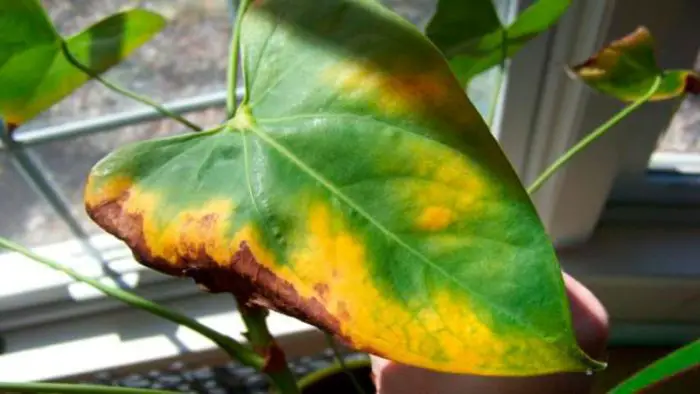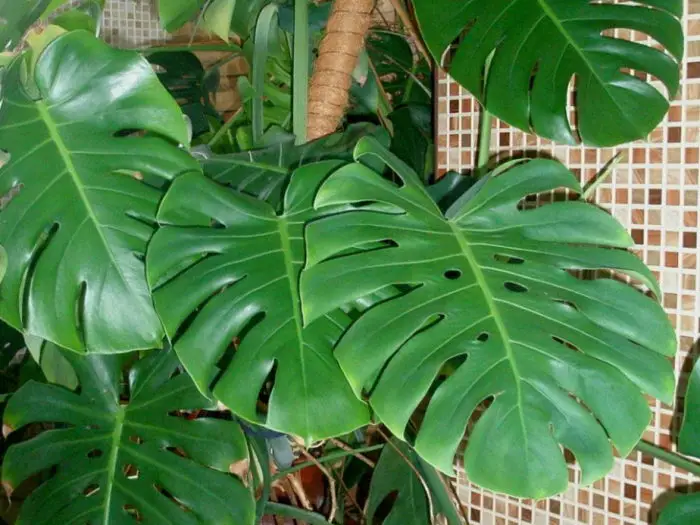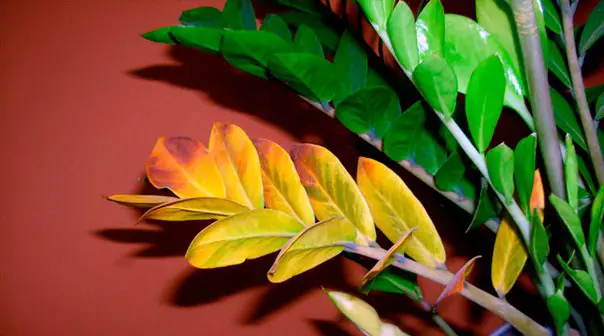Sometimes you face Indoor plant leaves turning yellow and brown even with proper care and compliance with the rules of maintenance. This may be due to the natural aging process of the flower. Then, soon new green leaves will appear on the site of the yellowed shoots. It is worse when this happens due to lack of nutrition, disease, excess or lack of lighting, pest attacks, etc. In this case, you will have to carefully monitor the behavior of the plant in order to timely detect the problem and find the right solution.

Healthy looking indoor plants
The experienced eye of a grower will always detect even minor changes in the appearance of a “green pet”. For those who are just starting the path of an amateur florist, it can be difficult to notice the presence of a problem.
The healthy appearance of a plant depends on the type of flower. So if you are in doubt about whether a houseplant is developing normally, look for information (with photographs) on the Internet or specialized literature.
A standard healthy plant species is determined by the following criteria:
- the flower grows normally, foliage is formed in a timely manner, it does not fade and does not turn yellow;
- the leaves are rich green;
- there are no defects or unnatural spots on the surface of the leaf blades or stems;
- leaves, buds and stems have an integral structure, there are no holes or damage in them, like those left by pests;
- the plant does not emit an unpleasant putrefactive smell, there are no traces of mold or mildew on the stems and leaf plates.
Important! The signs described above are conditional and refer to plants as a whole. The healthy appearance of a flower will depend on the variety. Therefore, it is worth asking in advance which manifestations will be normal for him and which will not.

Indoor plant leaves turning yellow and brown: Cause and Treatments
Often the reason for the plant leaves turning yellow and brown is improper or insufficient care of the plant. Each variety of indoor flowers requires special care. Therefore, before buying or planting, be sure to consult with a specialist or study special literature in order to know exactly what measures should be avoided when leaving.
Waterlogging of the soil
A common problem faced by most novice (and even experienced) florists. Waterlogging of the soil is especially dangerous for young plants, whose root system is not yet sufficiently formed. That is why, when planting or propagating certain types of indoor flowers, many people prefer to wait for the moment until the roots of the seedlings are finally formed.
Excessive soil moisture leads to the following consequences:
- waterlogging of the soil;
- decay of the root system of the flower;
- yellowing of healthy plant foliage;
- the appearance of a fungal infection or mold;
- reproduction of pests.
Important! You need to take urgent measures immediately after you notice changes in the appearance of the flower. Overflowing soil is especially dangerous since the root system suffers.
Watch the soil moisture level, do not water the plant if you feel that the soil is too wet. Be sure to provide all flowers with sufficient drainage to avoid stagnant water in the soil.
Some plant varieties only require watering if the soil is completely dry. In this case, you have to manually check the need for humidification. In rare situations, certain types of indoor flowers do not require watering; they receive moisture through spraying.
How often should indoor plants be watered?
The other side of the coin is insufficient soil moisture. This problem is faced by people who do not have enough time to care for houseplants. Do not forget that for green pets, water is the source of life, with which they receive many nutrients.
Poor watering causes the following problems:
- leaf plates begin to acquire a yellow-red hue;
- leaves, shoots, stems dry up;
- the root system of the plant dries up and dies off;
- the flower no longer reproduces new shoots and dies.
The solution in this case is simple pay attention to the plant. Give him enough moisture (but do not flood the soil). Adjust the watering mode, read the rules. The flower may not need much water.
change in room temperature
Plants, just like people, react negatively to temperature changes. They also suffer from acclimatization and adaptation to new temperature conditions. Even those who carefully monitor the health of flowers during the off-season often face a problem.
Signs of acclimatization:
- leaf plates turned yellow and covered with red spots;
- new shoots are poorly formed or not formed at all;
- the branches and stems of the plant look withered, sometimes leaf plates may fall off.
Important! Usually, this disease goes away when the temperature is normalized. During the adaptation period, support the “pet”: carefully observe the watering regime, add a little stimulant or top dressing to the soil, spray the flower. Find a place for him where the temperature is stable.
Will Frost kill my potted plants?
Yes, it will. If it is often difficult to do something with temperature extremes, then you can cope with frost. They are especially dangerous for tropical plant varieties.
It is forbidden to place indoor flowers next to such objects:
- open windows;
- split systems (powerful);
- fans.
The first sign that the plant does not like the atmosphere in the room is a change in the shade of the leaf plates. They can turn completely or partially yellow, turn brown or red spots, and then completely begin to fall off. The immune system of plants is extremely sensitive, remember this.
yellowing of leaves is due to deficiency of light
The correct lighting regime is just as important as the correct watering regime. If you notice that the leaves of the flower have turned noticeably yellow, but everything is in order with the temperature and moisture, then look for the reason in the type of lighting.
The lack of light can be compensated for as follows:
- Move the container with the indoor flower to a more lighted place.
- Place phytolamps around the plant.
- Use special fluorescent lights.
Important! Not all house flowers will be delighted with a lot of light. Some of them prefer shade or partial shade. Placing such a variety in bright light can result in burns and plant death.
An additional sign that the flower needs more light is uneven growth of the leaf plates. With a lack of light, it begins to reach for the window, internodes begin to lengthen, and the color of the leaves becomes heterogeneous. This is especially noticeable in domestic hibiscus.
The best way to solve the problem is by connecting artificial lighting. Phytolamps will give the flower enough light without burning its sensitive leaves and stems.
Sometimes it happens that even with the right light, the leaf plates continue to turn yellow early. Then the problem may be uneven lighting. To compensate for this deficiency, periodically turn the container over to the light so that the flower receives nutrition from all sides evenly.

Do leaves turn yellow from too much sun?
Some plant species are extremely sensitive to sunlight. Direct sunlight can cause leaf burns, which manifest as the following:
- yellow, red or brown spots appeared on the surface of the plates;
- leaves turned yellow and withered;
- damaged shoots fall off.
You can save the flower in this case, if the burn did not damage it too much. It is necessary to remove the pot from open light and try to carefully remove the damaged elements with a clean pruner. After that, pay extra attention to caring for the plant.
what nutrient deficiency causes yellow leaves?
Lack or absence of feeding nutrients can kill a houseplant during the initial stages of growth. Lack and excess of food are manifested in the form of certain symptoms:
- Magnesium. If the flower has small spots in the areas between the veins, which increase in size every day, then it lacks magnesium feeding.
- Copper. Copper “hunger” manifests itself in the same way as magnesium, with the only difference that in addition to orange and red spots, the leaf will acquire dryness and lose elasticity.
- Manganese. When there is a lack of an element, the color of the leaves will change to yellow-gray or yellow-green.
- Molybdenum. The lack of this element is manifested in the curling and yellowness of the leaves.
- Nitrogen. With a lack of nitrogenous feeding, the flower forms small foliage, which has a pale green color. Sometimes the leaves can form completely whitish.
- Calcium. If the tips of the plant noticeably began to turn yellow, this means that it suffers from a lack of calcium supplementation.
The lack of fertilizer should be compensated in time to avoid the death of the flower. But remember that lack of nutrients is just as bad as excess. It is best to consult with a specialist. He will tell you which drugs should be purchased if you have certain symptoms.
We have publication on Fertilizing Indoor Plants In Winter check it out.
The presence of an infectious disease
If insufficient or improper care can be corrected, then infectious diseases will not be able to solve the problem quickly and without consequences. The following pathologies can cause a sharp yellowing of the leaves:
- Fusarium. The disease primarily attacks the root system. Most often this happens with constant waterlogging of the soil. The roots of the flower begin to rot and die off, which leads to a change in the color of the leaves. The plant can only be saved by transplanting and removing rotten elements. If the roots have managed to rot completely, then the flower can only be reanimated through a new rooting.
- Late blight. Able to attack almost all types of plants, including indoor varieties. Leaves begin to wither, shoots and buds dry up. This infection can be defeated by spraying the aerial part with a solution of Fundazole.
- Anthracnose. Most dangerous for varieties with woody stem systems. The spread of infection occurs on the aerial part of the flower. The leaves begin to become covered with yellow spots, which eventually acquire a brown tint. The disease should be treated with fungicides.
This is an incomplete list of fungal infections that can infect indoor plants. The list goes on, but most of them cannot be defeated with the help of known drugs. So the fight against such diseases is only in the destruction of the affected flower.
Take a look at how often to water indoor plants in winter?
leaves turning yellow due to pests attack
Most pests are partial to the juice of indoor flowers. They attack mainly the stem and peduncles. Therefore, the flower begins to shed its leaves or change their color to yellow.
Severe damage can kill the plant. Therefore, it is necessary to inspect all parts of indoor flowers for the presence of pest colonies at least once a week.
More often than others, houseplants affect:
- Shield. These species settle in the form of colonies on leaf plates. They eat the green parts and drink the juice, the leaves quickly turn brown and fall off.
- Aphid. Symptoms similar to the previous ones.
- Spider mite. Loves balsams, begonias and hibiscus. Characteristic features are a sharp yellowing of the leaves and the formation of mealy cobwebs on the lower part of the leaf.
For pest control, you need to choose specialized drugs. Processing should be carried out carefully and more than once. With a general infection, the plant must be destroyed.
how to fix yellow leaves on plants?

The method of dealing with brown and yellowed leaves will depend on the reasons that caused the problem. There may be several factors:
- improper care;
- insufficient feeding;
- the presence of pests;
- infectious diseases.
Special Methods
Specialized tools can only help in cases where the leaf plates turn yellow due to insufficient feeding, the appearance of pests or an infection. Be sure to determine the cause so as not to destroy the plant with the wrong treatment.
The following compounds can help to overcome yellowness:
- fungicides (fight against infections and fungi);
- top dressing preparations (depending on which element the flower is missing);
- insecticides (insect and pest control).
In order to protect yourself and the plant, consult a specialist. He will tell you which drug to choose in a given situation.
Homemade solution for Indoor plant leaves turning yellow and brown
Folk recipes can only help in individual cases. For example, with the initial signs of damage to the plant by pests.
What should be done:
- First, isolate the damaged flower from healthy specimens.
- Remove any damaged leaves and stems from it with a clean and treated pruner. They can no longer be saved, so there will be little use in treatment.
- The spider mite, which more often than other insects infects indoor flowers, does not tolerate moisture. Give the plant a warm shower.
- Wipe the sheet plates with soapy water and then rinse thoroughly with clean water.
- Wrap the container with the flower in a bag and put it in a sunny place.
- After a couple of days, open the greenhouse, and wash the windowsill thoroughly with soap and water to eliminate any remaining pests.
How to prevent yellowing of housplants leaves?
The health of a “green pet” directly depends on preventive actions:
- Water the soil only when the top layer is dry.
- Do not forget to feed the plant, but add a little less than the recommended dose on the package.
- Flowers need a lot of light, but not in the open sun. So if it is not possible to provide them with diffused light, then get a phytolamp.
- Avoid temperature fluctuations and sudden changes in indoor humidity.
- Choose the right container for your flower. The plant should feel comfortable in it.
- Inspect flowers for pests or disease symptoms at least once a week.
Indoor plant leaves turning yellow and brown are only the initial signs of a problem. Therefore, carefully study the appearance and behavior of the flower and treat it correctly.
